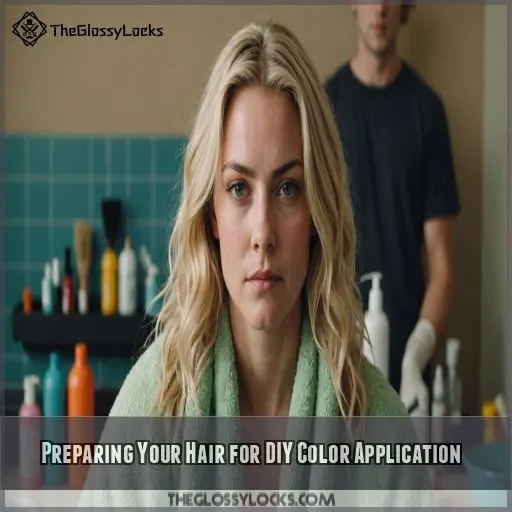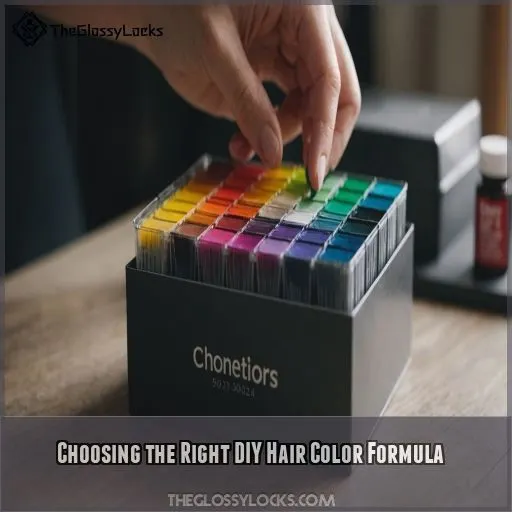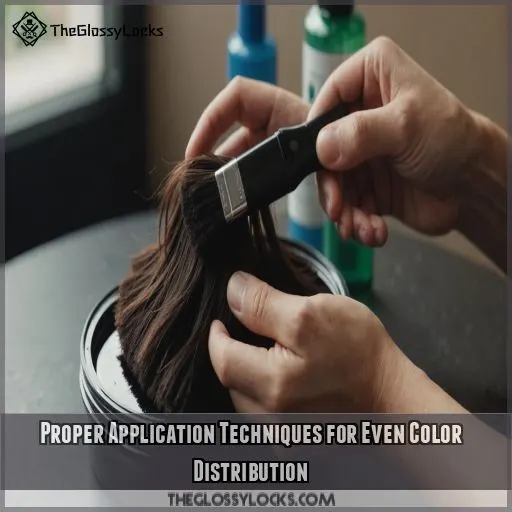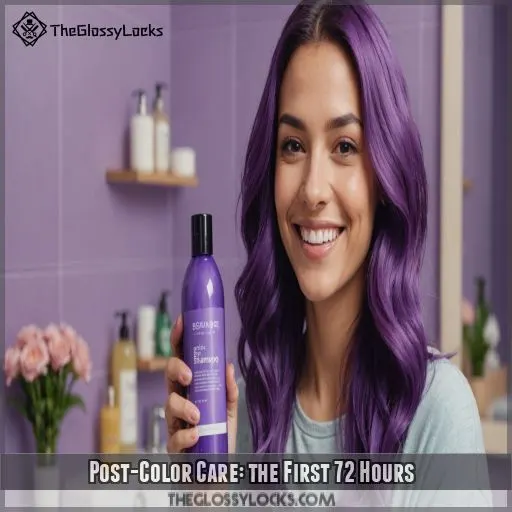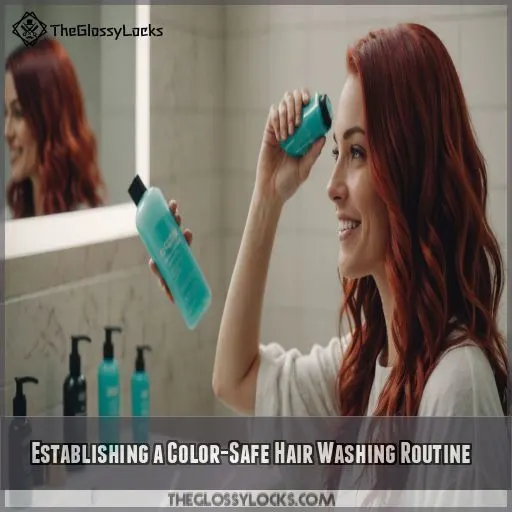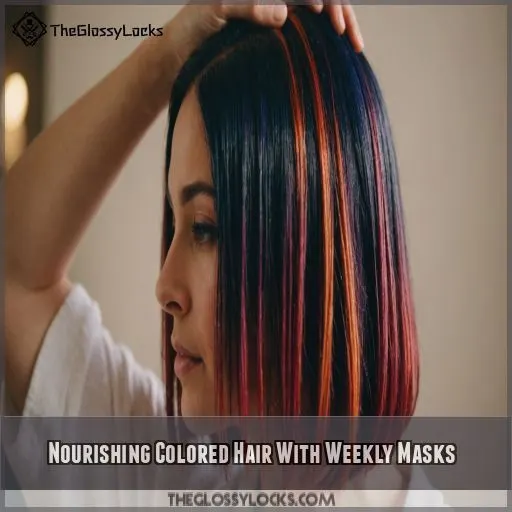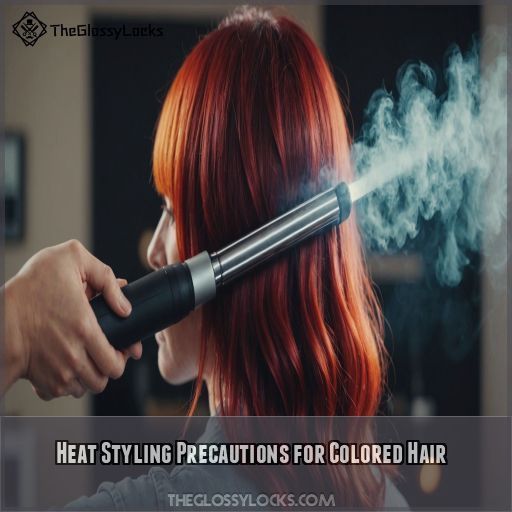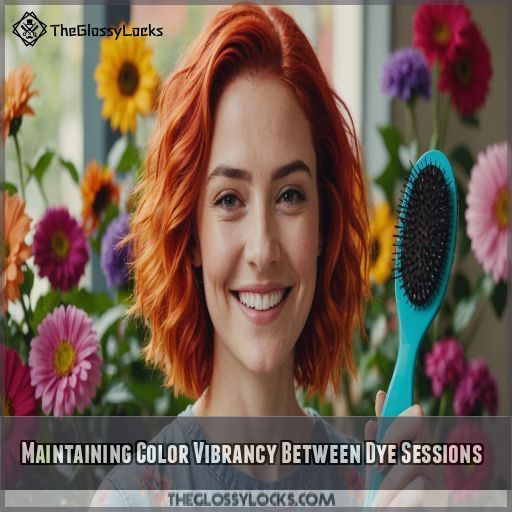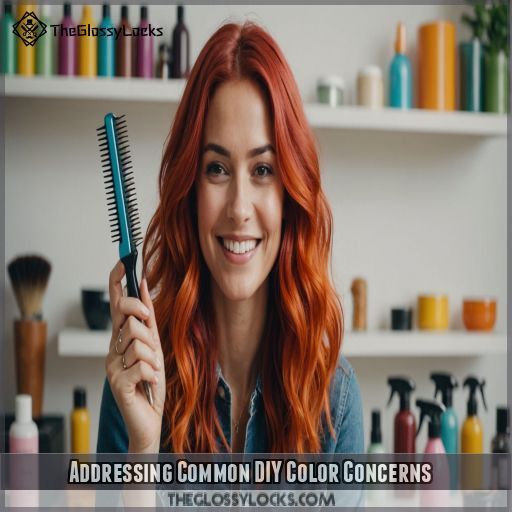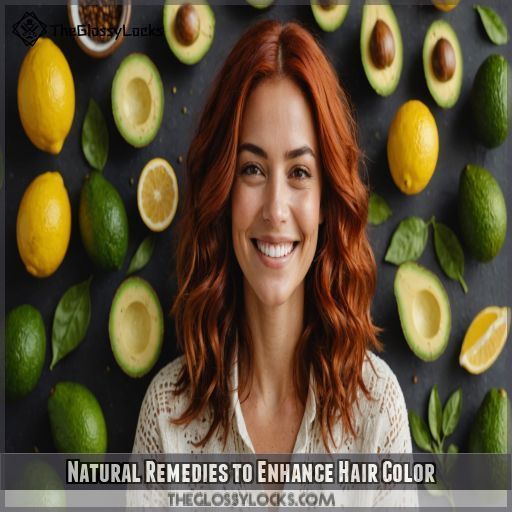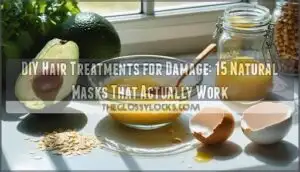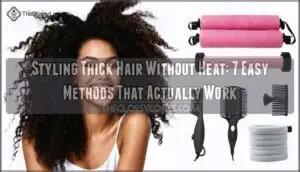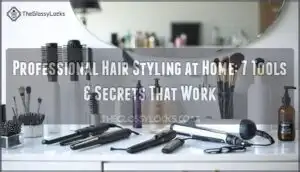This site is supported by our readers. We may earn a commission, at no cost to you, if you purchase through links.
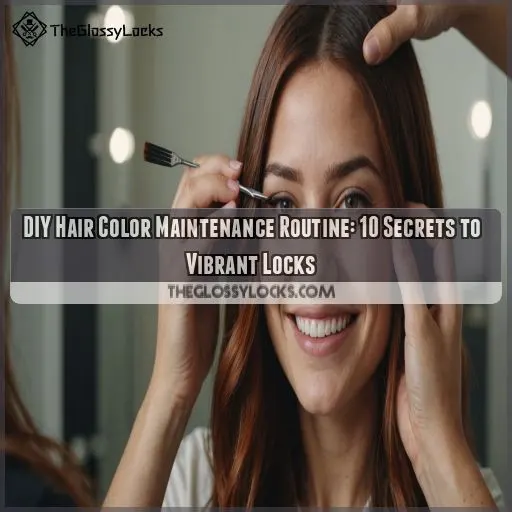 Mastering your DIY hair color maintenance routine is like taming a colorful beast—possible, rewarding, and fully under your creative spell!
Mastering your DIY hair color maintenance routine is like taming a colorful beast—possible, rewarding, and fully under your creative spell!
First, patch test to avoid any itchy surprises.
Famous last words: "What could possibly go wrong?"
Clarify and moisturize your hair pre-color for dreamy absorption.
Once your masterpiece is complete, show some TLC: steer clear of water for a bit and embrace color-safe products to keep that shade singing.
Love your locks with weekly pampering and UV shields, especially at the beach.
Stay tuned for golden nuggets on keeping those vibrant tresses the talk of the town!
Table Of Contents
- Key Takeaways
- Preparing Your Hair for DIY Color Application
- Choosing the Right DIY Hair Color Formula
- Proper Application Techniques for Even Color Distribution
- Post-Color Care: the First 72 Hours
- Establishing a Color-Safe Hair Washing Routine
- Nourishing Colored Hair With Weekly Masks
- Heat Styling Precautions for Colored Hair
- Maintaining Color Vibrancy Between Dye Sessions
- Addressing Common DIY Color Concerns
- Natural Remedies to Enhance Hair Color
- Frequently Asked Questions (FAQs)
- How to take care of colored hair at home?
- How can I prepare my hair for coloring at home?
- What to do after DIY hair color?
- What should I condition my hair before coloring?
- How often should I touch up my roots?
- Can colored hair benefit from protein treatments?
- What is a gloss treatment for colored hair?
- How to prevent chlorine damage to hair color?
- Are there specific vitamins to support hair color?
- Conclusion
Key Takeaways
- Prep Like a Pro: Think of your hair as a canvas that needs the perfect base before diving into color. Start with a patch test to dodge any itchy surprises, and give your hair a detox with clarifying shampoos and deep conditioning. Your hair will be ready to absorb color like a thirsty sponge!
- Master the Mix: Mixing and applying hair dye is your chance to channel your inner artist. With the right tools and techniques – like sectioning for even coverage and tackling those sneaky grays – you’ll leave no strand untouched. Remember, patience is your best friend here!
- Protect and Pamper: After coaxing your locks into their vibrant new shade, they deserve some TLC. Embrace color-safe shampoos, steer clear of sunlight like a vampire, and indulge in weekly moisture-rich masks. This care ensures your color doesn’t fade faster than ice cream in the sun.
- Keep the Vibrancy Alive: Stretch the time between dye sessions by using color-depositing products and shielding against chlorine and UV rays. Regular trims are like pruning a rose, keeping your color lively and your locks healthy. These small steps keep your hair the talk of the town!
Preparing Your Hair for DIY Color Application
Getting your hair ready for DIY color is like prepping a canvas for a masterpiece. You’ll want to start with a clean slate, nourish your locks, and set the stage for that perfect hue to shine through.
Patch Testing for Allergic Reactions
Before diving into your DIY hair color adventure, don’t skip the important patch test! This simple step can save you from a world of trouble. Here’s what you need to know:
- Apply a small amount behind your ear
- Wait 24-48 hours for any reactions
- Check for redness, itching, or swelling
- Repeat with each new product or formula
Deep Cleansing to Remove Product Buildup
Buildup can be a real hair color buzzkill. Before you go ahead and dye your hair at home, give your locks a fresh start. Use a clarifying shampoo to detoxify your hair and scalp, removing product residue that could interfere with color absorption. Your soon-to-be vibrant tresses will thank you!
Moisturizing Treatments for Optimal Color Absorption
Three days before coloring, treat your tresses to a deep conditioning session. Apply a nourishing hair mask or indulge in an overnight oil treatment. This pre-color pampering preps your locks for the best dye absorption, ensuring your new hue looks vibrant and lasts longer. Your hair will thank you!
Sectioning Hair for Even Application
Before diving into your DIY dye job, let’s talk sectioning – it’s the secret sauce for even color application. You’ll need:
- Rattail comb for precise partings
- Sectioning clips to keep hair in place
- Hair ties for larger sections
- Mirror for those tricky back areas
Choosing the Right DIY Hair Color Formula
Picking the right DIY hair color formula is key for getting the look you want and keeping your hair healthy. Whether you’re covering grays, tweaking your current shade, or trying out a bold new color, understanding your hair type and exploring different color formulas will help you get great results at home.
Hair Type Considerations
Wrapping your head around the nuances of hair texture and porosity levels is key. Got fine strands or thick tresses? They’ll sip up color differently, affecting hair color maintenance. Consider damage level and color history, too. Your locks’ past may whisper secrets. Pick a formula that dances well with your unique hair chemistry.
Color Formulation Options
Choosing the right color formulation options can feel like a puzzle, but you’re in control. Choose wisely:
- Use color charts for shade matching.
- Embrace tone correction with color-depositing products.
- Opt for formula customization using at-home kits.
- Add vibrancy with color-boosting conditioners or temporary hair color.
You got this!
At-Home Application Techniques
| Technique | Description |
|---|---|
| Root Touch-Up |
Focus on roots first to make sure you get full coverage, then work downwards.
Start with small amounts of dye and blend as you go to avoid harsh lines.
Follow instructions for processing time, but use a timer and your best judgment.
With these techniques, you’ll be a DIY color pro in no time!
Proper Application Techniques for Even Color Distribution
Achieving salon-quality color at home doesn’t have to be a messy guessing game if you’ve got the right game plan. With a little practice in applying the color evenly, focusing on the roots first, and managing grays, you’ll master a vibrant and consistent look every time.
Mixing the Color According to Instructions
Picking your formula sets the stage—now let’s mix! Grab the box and follow these steps to master the mix:
- Check color ratios and developer strength.
- Follow the recommended mixing time.
- Gear up with gloves and tools.
You’ve got this—your vibrant locks await!
Starting at the Roots and Working Downwards
Imagine you’re Picasso, painting a masterpiece. Root touch-up requires starting at the roots, then working downwards like a graceful balayage technique. By doing this, color blends beautifully. Combine this with proper hair sectioning for spot-on precision in your hair color treatment!
Ensuring Full Coverage of Gray Areas
Starting at the roots, it’s key to make sure you have full coverage, especially for grays that love playing hide-and-seek.
- Section Strategically: Use small sections for precise control.
- Brush Lightly: Coat strands without overloading.
- Mirror Check: Make sure no sneaky grays escaped.
Timing the Color Process Accurately
Precisely timing the color process is key – consider your hair’s porosity, the developer strength, and the desired shade depth. Carefully monitor the processing time to achieve even, long-lasting color results. Patience and attention to detail are your allies in DIY color success.
Post-Color Care: the First 72 Hours
Congratulations on your new hair color! For the first 72 hours, keep your locks dry, opt for color-depositing conditioners, and imagine you’re a vampire avoiding sunlight to keep your color vibrant.
Avoiding Water Contact for 24-48 Hours
Now that your application went off without a hitch, let’s discuss post-color care: avoid water for 24-48 hours to keep your hair color from fading faster than a melting ice cream on a summer day. This gives hair cuticles time to settle.
Using Color-depositing Conditioners
To keep your fresh color vibrant, reach for color-depositing conditioners. These clever formulas help replenish pigment and seal the cuticle, preventing premature fading. Apply after shampooing for a salon-smooth finish that lasts.
Protecting Hair From Heat and Sun Exposure
To keep your color fresh as a daisy, skip hair heat styling and embrace air drying. Use heat protectants if styling’s inevitable. Wear sun hats and apply UV filters to shield from damage. Sometimes, a cooling treatment is the perfect refresher!
Avoiding Harsh Chemical Treatments
Steer clear of harsh chemical treatments to keep your color vibrant. Giving your locks a breather helps that your recent dye job doesn’t fade faster than a snowman in the Sahara. Stick to natural hair dyes and color-safe products for gentle cleansing.
Establishing a Color-Safe Hair Washing Routine
Maintaining vibrant color-treated hair starts with a thoughtful washing routine. Opt for sulfate-free, color-safe shampoos, reduce wash frequency to preserve your hue, and seal the cuticle with cool water – then lock in moisture with leave-in treatments for salon-worthy results.
Selecting Sulfate-Free, Color-Safe Shampoos
After post-color care, let’s chat about shampoo. Opt for sulfate-free options to keep your color vibrant and locks luscious. Avoiding harsh ingredients means less color fade and dryness. Brands like IGK and Virtue Labs offer great hair color products for your shampoo routine.
Reducing Wash Frequency to Preserve Color
Washing too often makes color run faster than a sprinter! Instead, stretch those wash days. Embrace dry shampoo as your new best friend—it absorbs oil without causing color fading. Keep hair oils and scalp health in check, maintaining a vibrant hair color routine.
Using Cool Water to Seal the Cuticle
Switching to cool water during rinses locks in color vibrancy and enhances cuticle health. It might feel like a chilly surprise, but it smooths hair texture, reduces dullness, and ultimately saves you those extra salon visits. Your hair stylist will approve!
Applying Leave-in Treatments After Washing
Just finished using cool water? It’s time for leave-in treatments! They’ll keep your color looking fresh as a daisy. Consider these:
- Leave-in benefits: Moisture and shine.
- Product types: Sprays and creams.
- Application tips: Start at ends.
- Frequency: After each wash.
Nourishing Colored Hair With Weekly Masks
Keeping those beautiful colors vibrant isn’t just about the shade; it’s also about nourishing your hair with weekly masks. Give your locks the spa treatment they deserve with DIY masks that boost color, add strength, and hydrate, making your hair the envy of anyone who loves a pop of color!
DIY Color-Enhancing Hair Masks
Try out DIY color-enhancing hair masks to keep your hue fresh! By using natural ingredients like avocado or honey, you embrace a fun diy hair color maintenance routine. Protect your hair color from sun and chlorine, preventing unwanted fade while feeling fabulous!
Protein Treatments for Strengthening
Protein-rich treatments are a must for color-treated hair, as they help rebuild elasticity and strengthen strands weakened by chemical processing. Try an at-home keratin mask to revive damaged locks and keep your vibrant hue looking its best.
Moisture-Rich Masks for Hydration
Hydrating your vibrant locks with DIY masks is like giving your hair a cozy hug! Craft these weekly wonders with rich ingredients that match your hair type. Here’s what to think about:
- Mask Frequency
- Mask Ingredients
- Deep Conditioning Schedule
Scalp Treatments to Support Healthy Growth
For healthy growth, love your scalp like a garden. Regular massages boost blood flow to hair follicles, nurturing and invigorating them. Don’t just shampoo and go; indulge in scalp care. Maintain scalp health, prevent dryness, and enhance hair growth effortlessly!
Heat Styling Precautions for Colored Hair
Colored hair requires extra care when heat styling to prevent damage and preserve vibrancy. Reach for heat protectants, lower your tool settings, and consider heat-free styling options to keep your color looking fresh.
Using Heat Protectants Before Styling
Before you turn up the heat, grab a heat protectant! It’s like a superhero shield for your color-treated hair against those villainous styling tools. Try these:
- Sprays
- Creams
- Serums
- Oils
- Mists
Protect your vibrant locks from heat damage!
Lowering Heat Settings on Styling Tools
You’ve mastered using heat protectants, now let your hair breathe by reducing the heat settings on your styling tools. High heat leads to damage—yikes! Try lower settings for healthier, vibrant hair. You’ll feel like a haircare wizard, trust me.
Embracing Heat-Free Styling Methods
Wave goodbye to heat damage by embracing heat-free styling methods! Try air drying for natural texture, achieving soft overnight waves with braids, or creating stunning heatless curls. Don’t forget those chic hair accessories—perfect for mastering flawless looks while giving your locks freedom.
Deep Conditioning After Heat Styling Sessions
While embracing heat-free styles, remember, heat styling can damage colored hair. Deep conditioning after each session safeguards your strands. Here’s how:
- Apply a nourishing hair mask.
- Boost moisture retention.
- Repair cuticles.
- Rejuvenate your styling routine.
Your hair’s happy place!
Maintaining Color Vibrancy Between Dye Sessions
You don’t need a salon trip to keep your hair color vibrant; just some smart habits and a few tricks up your sleeve. Keep those colors popping by using color-depositing products, shielding your hair from damage like saltwater and sun, and giving it regular trims to keep the fade away.
Using Color-Depositing Products
Breathe new life into your color with color-depositing products! These handy color refreshers and glosses help maintain vibrancy between dye sessions. Pair them with color-safe conditioners for a salon-worthy DIY color maintenance routine.
Protecting Hair From Chlorine and Salt Water
Imagine this: You’re heading for the pool, but chlorine damage or saltwater effects can fade your gorgeous hue. For pool hair care, wet your hair first, use a protective cap, and apply nourishing hair masks afterward. Your vibrant locks will thank you!
Applying UV Protection for Outdoor Activities
When venturing outdoors, shield your color-treated tresses with uv-blocking products. Slip on a wide-brimmed sun hat, and consider a leave-in spray to safeguard against chlorine and salt water – the keys to preserving your vibrant hue.
- Lightweight UV-protection sprays
- Broad-spectrum sun hats
- Color-depositing leave-in conditioners
- Clarifying rinses after swimming
- Deep conditioning treatments
Regular Trims to Prevent Color Fading
Guard against fading and split ends by embracing regular trims. It seems counterintuitive, right? Yet snipping every 6-8 weeks keeps color vibrant and hair healthy. Think of it like pruning a rose for that perfect bloom – salon visits help keep your hair looking its best.
| Trimming Frequency | Color Vibrancy | Hair Health |
|---|---|---|
| Every 6 Weeks | Enhanced | Excellent |
| Every 8 Weeks | Maintained | Good |
| Skipped Trims | Reduced | Compromised |
| Yearly | Minimal | Poor |
Addressing Common DIY Color Concerns
Tackling DIY hair color issues doesn’t have to feel like a battle — even if your latest color experiment went a bit sideways! Whether it’s taming rogue brassy tones or camouflaging those sneaky roots, we’ll guide you with tips that save both your sanity and salon budget.
Fixing Uneven Color Application
- Apply a root touch-up for uniformity.
- Use toner for color blending.
- Enhance with partial color corrections.
- Keep color fading at bay.
Toning Brassy or Unwanted Undertones
If your hair resembles an orange traffic cone, a purple shampoo can work wonders! It’s a brassiness fix that’s easy-peasy. Choose the right toner type to tackle unwanted hues, ensuring color correction before you notice any fading. Freedom awaits, champ!
Managing Root Regrowth Between Colorings
Root regrowth giving you a run for your money? Try root touch-up techniques to tame those intruders. Root shadowing is like a magic trick that keeps color looking fresh. Color refreshers? They’re your secret weapon between in-between color appointments, preventing pesky color fading!
Correcting Over-Processed or Damaged Hair
Over-processed hair can feel like a wild rollercoaster ride, leaving you yearning for smooth tracks. Here’s how to fix it:
- Deep condition weekly with nourishing hair masks.
- Try protein treatments to strengthen strands.
- Use a hair gloss for shine.
- Apply color correction techniques carefully.
Natural Remedies to Enhance Hair Color
Tired of dull, lifeless color? Discover the power of natural remedies to revive your hair’s vibrancy and shine. From herbal rinses to nourishing oils, these DIY solutions will have your color-treated tresses looking salon-fresh between dye sessions.
Herbal Rinses for Color Boost
Herbal rinses work wonders for a DIY color boost. To prevent color fade, try rinsing with rosemary or sage tea; these herbal rinse recipes offer natural color enhancement. You’ll love the hair health benefits, too—it’s like adding a little sunshine to your locks!
DIY Color-Enhancing Hair Oils
Alongside herbal rinses, DIY color-enhancing hair oils are your ace in the hole for vibrant locks. Try these blends:
- Rosemary Oil: Boosts growth.
- Camellia Oil: Adds shine.
- Argan Oil: Hydrates.
- Jojoba Oil: Balances scalp.
Store them cool!
Natural Ingredients for Shine and Gloss
To boost your DIY hair masks, consider these gems: Apple cider vinegar rinse for shine, Coconut oil benefits like smoothness, or an Avocado hair treatment for deep hydration. For a touch of color, Henna gloss treatments can add vibrancy and gloss naturally.
| DIY Hair Mask | Benefits | Key Ingredient |
|---|---|---|
| Apple Cider Vinegar | Adds Shine | Vinegar |
| Coconut Oil Treatment | Provides Smoothness | Coconut Oil |
| Avocado Mask | Deep Hydration | Avocado |
Dietary Changes to Support Healthy Hair Color
Did you know your diet can influence hair color vibrancy? Incorporating protein sources like eggs and fish boosts hair growth. Biotin intake from nuts helps too! Keep iron deficiency at bay with spinach, and don’t forget you’re only a glass away from good hydration levels.
Frequently Asked Questions (FAQs)
How to take care of colored hair at home?
Did you know colored hair‘s like a high-maintenance friend? Use color-safe shampoos, avoid sulfates, and pamper it with weekly masks. Limit heat styling and wash less to maintain vibrancy. Your hair will thank you!
How can I prepare my hair for coloring at home?
Before coloring at home, prep your hair by using a deep conditioning treatment to hydrate and strengthen strands. This’ll help minimize damage and make sure your new hue looks vibrant and lasts longer. Trust me, your hair will thank you!
What to do after DIY hair color?
After DIY hair color, embrace vibrant locks by using color-safe, sulfate-free products. Avoid hot water and excessive sun to keep colors bright. Treat your hair like a delicate treasure, nurturing it with moisture-rich masks and heat protection (Source).
What should I condition my hair before coloring?
Think of conditioning your hair before coloring like prepping a wall before painting. Use a deep, moisturizing conditioner to nourish your hair, ensuring it’s as soft and smooth as a silk sheet, ready for vibrant color.
How often should I touch up my roots?
Touch up your roots every four to six weeks to keep things looking fresh. Think of it as a little pampering session for your hair—like spring cleaning but for your scalp. You’ll keep your color vibrant and polished!
Can colored hair benefit from protein treatments?
Think of protein treatments as a safety net for your color-treated hair—providing strength and resilience. They help repair damage and reduce breakage. However, don’t overdo it, as too much protein can make hair stiff.
What is a gloss treatment for colored hair?
A gloss treatment for colored hair is like a topcoat for your nails. It boosts shine, revives color, and adds a protective layer. This quick fix makes your hair glow like it’s fresh from the salon.
How to prevent chlorine damage to hair color?
To prevent chlorine damage to your hair color, wet hair before swimming, use a leave-in conditioner, and wear a swim cap. Rinse immediately after swimming and use a clarifying shampoo to remove chlorine buildup (Source).
Are there specific vitamins to support hair color?
While specific vitamins like biotin, vitamin C, and iron can support hair health, the best approach for color-treated hair is to use products formulated for color-treated hair. (Source) This will help maintain vibrancy and prevent damage.
Conclusion
Breathing life into your DIY hair color maintenance routine is like painting a personal masterpiece, dynamic, bold, and uniquely yours.
It’s all about giving your hair the love it deserves through consistent care.
Embrace weekly pampering, choose color-safe products, and protect against the elements.
Now, go on and let your colorful mane dazzle!

